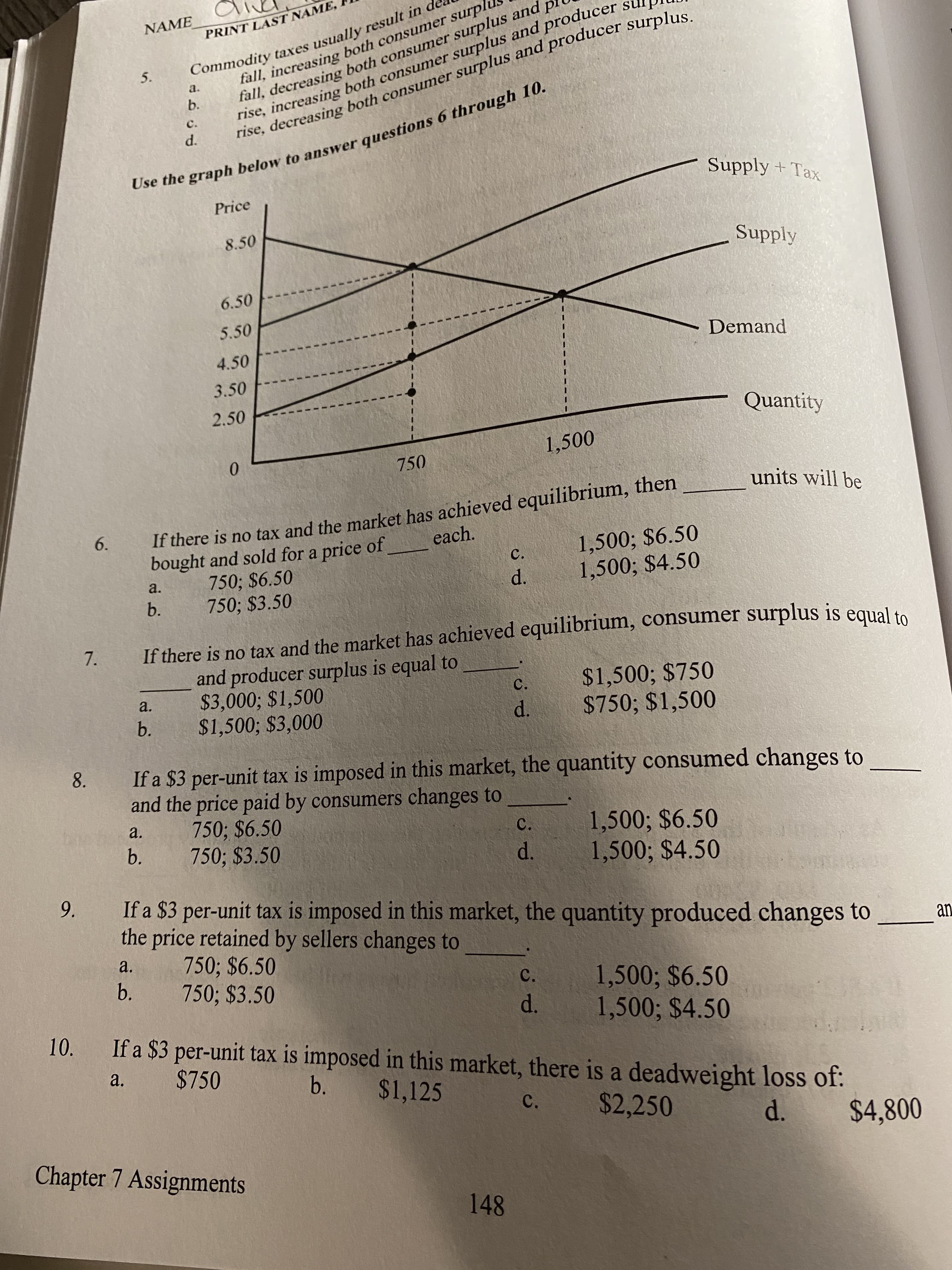tall, increasing both consumer surpli tall, decreasing both consumer surplus and rise, increasing both consumer surplus and producer rise, decreasing both consumer surplus and producer surplus. NAME PRINT LAST NAME, 5. Commodity taxes usually result in de a. b. C. d. Use the graph below to answer questions 6 through 10. Supply + Tax Price 8.50 Supply 6.50 5.50 Demand 4.50 3.50 2.50 Quantity 1,500 750 units will be If there is no tax and the market has achieved equilibrium, then 1,500; $6.50 1,500; $4.50 6. each. bought and sold for a price of C. 750; $6.50 750; $3.50 a. d. b. If there is no tax and the market has achieved equilibrium, consumer surplus is equal and producer surplus is equal to $3,000; $1,500 $1,500; $3,000 $1,500; $750 $750; $1,500 a. C. b. d. If a $3 per-unit tax is imposed in this market, the quantity consumed changes to and the price paid by consumers changes to 750; $6.50 750; $3.50 8. a. 1,500; $6.50 1,500; $4.50 C. b. d. 9. If a $3 per-unit tax is imposed in this market, the quantity produced changes to the price retained by sellers changes to an 750; $6.50 750; $3.50 a. b. 1,500; $6.50 1,500; $4.50 C. d. If a $3 per-unit tax is imposed in this market, there is a deadweight loss of: 10. a. $750 b. $1,125 C. $2,250 d. $4,800 Chapter 7 Assignments 148 1. 7.
tall, increasing both consumer surpli tall, decreasing both consumer surplus and rise, increasing both consumer surplus and producer rise, decreasing both consumer surplus and producer surplus. NAME PRINT LAST NAME, 5. Commodity taxes usually result in de a. b. C. d. Use the graph below to answer questions 6 through 10. Supply + Tax Price 8.50 Supply 6.50 5.50 Demand 4.50 3.50 2.50 Quantity 1,500 750 units will be If there is no tax and the market has achieved equilibrium, then 1,500; $6.50 1,500; $4.50 6. each. bought and sold for a price of C. 750; $6.50 750; $3.50 a. d. b. If there is no tax and the market has achieved equilibrium, consumer surplus is equal and producer surplus is equal to $3,000; $1,500 $1,500; $3,000 $1,500; $750 $750; $1,500 a. C. b. d. If a $3 per-unit tax is imposed in this market, the quantity consumed changes to and the price paid by consumers changes to 750; $6.50 750; $3.50 8. a. 1,500; $6.50 1,500; $4.50 C. b. d. 9. If a $3 per-unit tax is imposed in this market, the quantity produced changes to the price retained by sellers changes to an 750; $6.50 750; $3.50 a. b. 1,500; $6.50 1,500; $4.50 C. d. If a $3 per-unit tax is imposed in this market, there is a deadweight loss of: 10. a. $750 b. $1,125 C. $2,250 d. $4,800 Chapter 7 Assignments 148 1. 7.
Principles of Microeconomics
7th Edition
ISBN:9781305156050
Author:N. Gregory Mankiw
Publisher:N. Gregory Mankiw
Chapter6: Supply, Demand And Government Policies
Section: Chapter Questions
Problem 10PA
Related questions
Question
Question 7

Transcribed Image Text:tall, increasing both consumer surpli
tall, decreasing both consumer surplus and
rise, increasing both consumer surplus and producer
rise, decreasing both consumer surplus and producer surplus.
NAME
PRINT LAST NAME,
5.
Commodity taxes usually result in de
a.
b.
C.
d.
Use the graph below to answer questions 6 through 10.
Supply + Tax
Price
8.50
Supply
6.50
5.50
Demand
4.50
3.50
2.50
Quantity
1,500
750
units will be
If there is no tax and the market has achieved equilibrium, then
1,500; $6.50
1,500; $4.50
6.
each.
bought and sold for a price of
C.
750; $6.50
750; $3.50
a.
d.
b.
If there is no tax and the market has achieved equilibrium, consumer surplus is equal
and producer surplus is equal to
$3,000; $1,500
$1,500; $3,000
$1,500; $750
$750; $1,500
a.
C.
b.
d.
If a $3 per-unit tax is imposed in this market, the quantity consumed changes to
and the price paid by consumers changes to
750; $6.50
750; $3.50
8.
a.
1,500; $6.50
1,500; $4.50
C.
b.
d.
9.
If a $3 per-unit tax is imposed in this market, the quantity produced changes to
the price retained by sellers changes to
an
750; $6.50
750; $3.50
a.
b.
1,500; $6.50
1,500; $4.50
C.
d.
If a $3 per-unit tax is imposed in this market, there is a deadweight loss of:
10.
a.
$750
b.
$1,125
C.
$2,250
d.
$4,800
Chapter 7 Assignments
148
1.
7.
Expert Solution
This question has been solved!
Explore an expertly crafted, step-by-step solution for a thorough understanding of key concepts.
This is a popular solution!
Trending now
This is a popular solution!
Step by step
Solved in 4 steps with 2 images

Knowledge Booster
Learn more about
Need a deep-dive on the concept behind this application? Look no further. Learn more about this topic, economics and related others by exploring similar questions and additional content below.Recommended textbooks for you

Principles of Microeconomics
Economics
ISBN:
9781305156050
Author:
N. Gregory Mankiw
Publisher:
Cengage Learning

Principles of Microeconomics
Economics
ISBN:
9781305156050
Author:
N. Gregory Mankiw
Publisher:
Cengage Learning